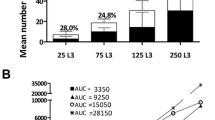Abstract
LEWIS rats, in contrast to NMRI mice, have been found to be resistant to an oral infection withNematospiroides dubius (Baylis, 1926). Comparative studies of the peritoneal response to infection showed a strong increase in the cell number predominantly of eosinophilic and neutrophilic granulocytes in rats, whereas in mice only a weak reaction occurred. As shown by the chemiluminescence response to either antibody — or complement-coated larvae, the granulocyte reaction caused an increased production of toxic oxygen species by the peritoneal cells. Purified granulocytes from rats or mice showed about a tenfold higher oxidant generation than macrophages. The higher metabolic activity of granulocytes of either species resulted in rapid and strong killing of antibody or complement-coated infective larvae by granulocytes of either species, whereas macrophages failed to express a significant larvicidal potency.
From these results we concluded that the activated oxygen species derived from the metabolic burst of granulocytes are essential for an effective control of the primary infection withN. dubius. This suggests that the rapid and strong granulocyte response may form the basis of the resistance in rats. Thus, in mice, the ability ofN. dubius to prevent the granulocyte response may serve as an escape mechanism of the parasite.
Similar content being viewed by others
References
Allen RC, Loose LD (1976) Phagocytic activation of a luminoldependent chemiluminescence in rabbit alveolar and peritoneal macrophages. Biochem Biophys Res Commun 69:245–252
Bass DA, Szejda P (1979) Eosinophils versus neutrophils in host defense. Killing of newborn larvae ofTrichinella spiralis by human granulocytes in vitro. J Clin Invest 64:1415–1422
Basten A, Beeson PB (1970) Mechanism of eosinophilia. II. Role of the lymphocyte. J exp Med 136:1288–1305
Behnke JM, Parish HA (1979) Expulsion ofNematospiroides dubius from the intestine of mice treated with immune serum. Par Immunol 1:13–26
Butterworth AE (1977) The eosinophil and its role in immunity to helminth infection. Curr Top Microbiol 77:127–168
Chaicumpa V, Prowse SJ, Ey PL, Jenkin CR (1977) Induction of immunity in mice to the nematode parasiteNematospiroides dubius. Aust J Exp Biol Med Sci 55:393–400
Dobson C (1962) Certain aspects of host-parasite relationship ofNematospiroides dubius (Baylis). Parasitology 52:41–48
Glick D, von Redlich D, Juhos ETh, McEwen CR (1971) Separation of mast cells by centrifugal elutriation. Exp Cell Res 65:23–26
Greenberg Z, Wertheim G (1973) The cellular responses of the rat to an intraperitoneal inoculation ofNippostrongylus brasiliensis larvae. Immunology 24:531–543
Jones CE, Rubin R (1974)Nematospiroides dubius: Mechanisms of host immunity. I. Parasite counts, histopathology and serum transfer involving orally or subcutaneously sensitized mice. Exp Parasitol 35:434–452
Kazura JW, Fanning MM, Blumer JL, Mahmond AAF (1981) Role of cell-generated hydrogen peroxide in granulocyte-mediated killing of schistosomula ofSchistosoma mansoni in vitro. J Clin Invest 67:93–102
Mackenzie CD, Taylor PM, Ogilvie, BM (1980) Activation of complement, the induction of antibodies to the surface of nematodes and the effect of these factors and cells on worm survival invitro. Eur J Immunol 10:594–601
Mitchell GF (1979) Responses to infection with metazoan and protozoan parasites in mice. Adv Immunol 28:451–470
Prowse SJ, Ey PL, Jenkin CR (1978a) Immunity toNematospiroides dubius: Cell and immunoglobulin changes and the onset of immunity in mice. Aust J Exp Biol Med Sci 56:237–246
Prowse SJ, Mitchell GF, Ey PL, Jenkin CR (1978b)Nematospiroides dubius: Susceptibility to infection and the development of resistance in hypothymic (nude) Balb/c mice. Aust J Exp Biol Med Sci 56:561–570
Prowse SJ, Ey PL, Jenkin CR (1979) Alternative pathway activation of complement by a murine parasitic nematode (Nematospiroides dubius). Aust J Exp Biol Med Sci 57:459–466
Root RK, Metcalf J, Oshino N, Chance B (1975) H2O2 release from human granulocytes during phagocytosis. I. Documentation, quantitation and some regulation factors. J Clin Invest 55:945–955
Rosen H, Klebanoff SJ (1979) Bactericidal activity of a superoxide anion-generating system. A model for the polymorphonuclear leukocyte. J Exp Med 149:27–39
Wrogemann K, Weidemann MJ, Peskar BA, Staudinger Hj, Rietschel ETh, Fischer H (1978) Chemiluminescence and immune cell activation. I. Early activation of rat thymocytes can be monitored by chemiluminescence measurements. Eur J Immunol 8:749–752
Author information
Authors and Affiliations
Rights and permissions
About this article
Cite this article
Schmitz, B., Possart-Schmitz, P., Gehrung, M. et al. Cellular response and resistance to the primary infection of rats and mice withNematospiroides dubius . Z. Parasitenkd. 68, 339–347 (1982). https://doi.org/10.1007/BF00927412
Accepted:
Issue Date:
DOI: https://doi.org/10.1007/BF00927412



